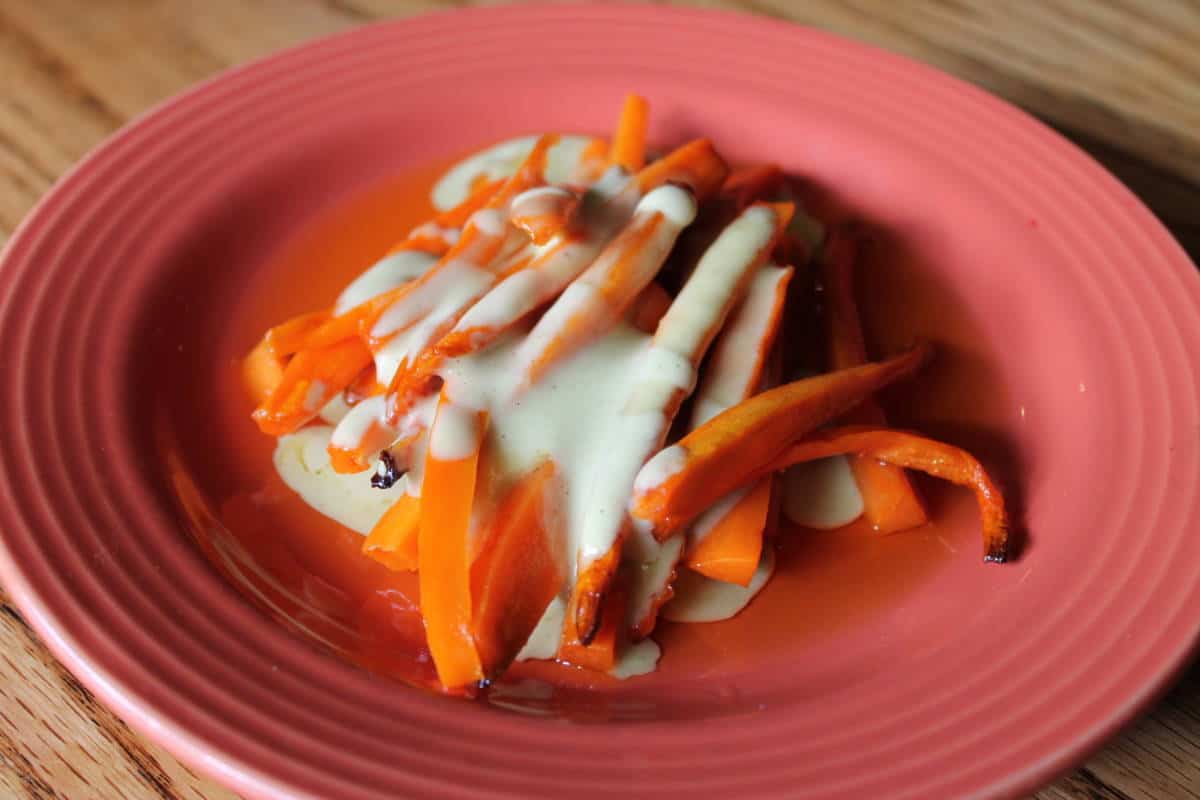
Beets enjoy a devoted fan club, but some tell beets to beat it. Many people turn to turnips with smiles, but others quickly turn away. Some of us loudly root for rutabagas, but the root vegetable also attracts unruly mobs fixed on giving rutabagas the boot.
It’s not always easy being a root vegetable.
Unless you are a carrot. What kind of lunatic rejects carrots? Everybody loves carrots! Us included.
Just as onions serve as a year-round foundation for our uniquely comprehensive approach to farm-to-table, so do carrots. We plant and harvest them for much of the year, and serve carrots year-round. Over the course of a year, Black Cat Farm sends about 5,500 pounds of carrots to the restaurants.
If you think a carrot is a carrot is a carrot, think again. The vegetable has myriad varietals. The Nantes carrot is the classic — long, skinny, beautiful. Eric calls them “Vogue” carrots, due to their model-like qualities. And we don’t grow them on Black Cat Farm.
“Nantes carrots are famous for being orange blocks of water. No flavor,” says Eric. “Turns out flavor is a big deal to us.”
Instead, Eric selects Chantenay, Jaune du Doubs, and Shin Kuroda carrots for the fields.

Chantenay: It’s blocky, short and conical shaped — perfect for pushing through Boulder County’s rough soil. “They have a rich, deep, wonderful flavor and they sweeten-up much better and earlier than Nantes carrots,” says Eric. “They don’t sell as well at the Farmers’ Market, because people want the Vogue carrots. They are great for Instagram. But most of our carrots go to the restaurants, where flavor is paramount.”
Jaune du Doubs: This old French heirloom, which is yellow, is not made for eating raw — it’s too intensely flavored, and spicy. But cooking mellows the carrot, yielding rich flavors. They find their way into numerous dishes at the restaurant. One of Eric’s favorite Jaune du Doubs dishes is a carrot-ginger soup. It’s vivid yellow, and incandescent with lively flavor.
Shin Kuroda: The restaurants need smaller carrots for different dishes — among other things, a whole carrot can look spectacular on a plate. The Japanese varietal Shin Kuroda is our go-to carrot for these whole-carrot needs. “It’s the perfect size and shape to leave as a whole carrot, or just cut in half. So if we want to present a roasted carrot on a plate, we often rely upon Shin Kurodas,” says Eric. Because they are small, they do not store well. So the restaurants serve Shin Kurodas for as long as they are being harvested fresh from the fields — roughly six months.
We plant carrots every few weeks, and are seeding the last batch in about two weeks. These carrots will over-winter — unless we have an especially frigid winter (these have been in short supply for the past few years in Boulder), we should be harvesting them in all of their gorgeousness through the winter and spring.
Roasted Carrots with Tarator Sauce
If you have ever dined at Bramble & Hare, you might have ordered our roasted carrots with tarator sauce. It’s a simple dish (as so many of the best are), and immensely popular; should we ever remove it from the menu, we would worry about Boulder-wide protests.

- 1 2-pound bunch of carrots
- 1 cup sunflower oil
- tarator sauce
Remove the tops from the carrots. Trim and peel the carrots if necessary. Wash the carrots and dry. Cut the carrots into finger-size pieces, each about 4 inches long. Transfer the carrots to a medium mixing bowl. Add the sunflower oil and season with salt. Toss to combine. Transfer carrots to a baking sheet and place in the oven. Roast carrots until tender and just beginning to brown, about 8 minutes. Transfer the roasted carrots to a serving bowl and top with tarator sauce. Serve immediately.
Tarator Sauce
- 1 cup toasted almonds
- 2 tablespoons roasted garlic
- ¼ cup sunflower oil
- sea salt
- lemon juice
In a food processor, combine the nuts, garlic, and 2 tablespoons water. Process on high speed until very smooth, scraping the sides of the bowl if necessary. With the motor running, slowly add the oil until fully incorporated. Season with salt and lemon juice. Store in a tightly covered container in the fridge for up to 4 days.

Interested in one of the most fabulous food events of the year? Excellent — it’s right around the corner, and since we are sponsoring the event, we’ve got all of the details. Please join us in the middle of 13th Street in front of Black Cat Bistro and Bramble & Hare (don’t worry — the street is blocked off for the event) for the James Beard Foundation Celebrity Chef Tour (www.jamesbeard.org/events/boulder?). The event, starting at 6:30 p.m. on Saturday, September 8, involves ambitious, nationally renowned chefs from across the country who all share at least one thing: they all take farm-to-table seriously, just like us. The night includes a reception with passed plates and adult beverages, a spectacular six-course dinner (we will be sending along more details, including some highlighted dishes and featured chefs, in coming weeks) and much conversation about the many important places where farm and culinary intersect. Please visit the above links to make reservations. Tickets are selling fast — we hope to see you there, on the street!

We look forward to seeing you at the Market on Saturday.
At the prepared food stall, we will be serving:
- •Pork burgers
- •Lamb gyros
- •Pork loin plate with baba ganoush, roasted turnips, broccoli and chimichurri
- •Prepared salads
At the produce stand, you will find:
- Lettuce varieties
- Arugula
- Tat Soi
- Pak Choi
- Mizuna
- Chinese collards
- Hakurei turnips
- Radishes
- Broccoli
- Beets
- Carrots
- Onions
- Fennel
- Potatoes
- Squash blossoms
- Peppers
- Eggplants
- Wax Beans
- Cucumbers
- Tomatilloes
- All pork cuts
